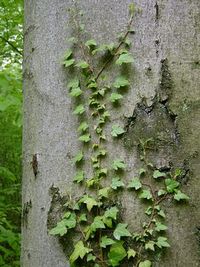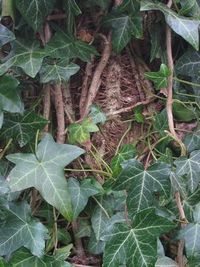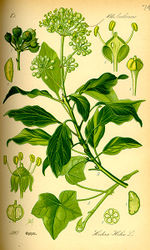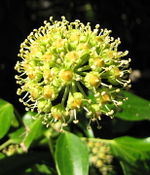Ivy
| Ivy |
|---|

|
| Scientific Classification |
|
| Species |
|
An ivy is any of the species of plants belonging to the taxonomic genus Hedera. It is an evergreen perennial shrub that is know for its green leaves, sturdy vines, and its ability to climb vertical structures. They secure themselves onto the trees with an adhesive produced from the rootlets on the stem. When identifying the different species examine the underside of the leaves. Their leaves are green, waxy, palmate, and lobed. The stems are flexible when they are young and begin to climb. When it has reached the place that will be most beneficial to the plant, the vines (stem) will harden and become woody.[3]
Body Design
The genus Hedera (common ivy) contains plants that have many distinct physical characteristics. They are evergreen and perennial (grow year after year). The leaves of these ivies are dark green, slightly leathery, and grow alternately from each other on the stem. The venation of the leaves is simple palmate which means there are two or more veins originating from a single point. The ivy has two different types of leaves, juvenile and adult.[4]The adult leaves are more of an umbrella shape then the juvenile ones, and with a bigger surface area it absorbs the sunlight better. The juvenile leaves are the leaves typically seen on ivy’s they are 3-5 lobed leaves and are ones that tend to cover the ground. The adult leaves are found near the top of the object it has climbed where the majority of the sun light is. These leaves are on the fertile flowering stem.
The plant grows taller by climbing up many different types of structures like trees, walls, and houses. The roots on the ivies are advantageous and climbing roots. They grow on a stem, petiole, and leaves. The roots also produce a glue like substance to help the plant stick to the surface it is climbing.[3] On the juvenile leaves there are little rootlets that grow at the leaf node on the stem. These rootlets hold the plant securely against a vertical structure. These ivies use the vertical structure for support and a way to reach the sunlight better. When the plant matures the flexible stem becomes woody and sturdy. [5]
Life Cycle
The Ivy has two stages in their life cycle; the juvenile and adult stage. The juvenile stage does most of the climbing of the ivy. Rootlets sprout out from the leaf nodes and attach to the vertical surface.
In the adult stage the ivy stops climbing and leaves change in appearance.The ivy only reproduces in the adult phase. Genus Hedera reproduction is the same as the other angiosperms. They flower in the fall and produces fruit in the spring. The ivy has small greenish white flowers that are produced in clusters.[6] The plants ovaries are 5-lobed and contain five ovules The fruit is a black berry with 1 to 4 seeds, occasionally it has 5 seeds. The seeds are mostly on the ground of the host tree or spread by birds.[7]
Ecology
Ivy are native to Europe specifically England, Ireland, the Mediterranean region, and northern Europe west of the Caucasus Mountains. There is a large population of ivy in the American Pacific Northwest. Ivy thrives almost everywhere except in extremely dry or water logged areas. Since they are evergreen the leaves do not change color with the seasons. The plant gets food from photosynthesis.
There are a number of people who believe that they are a parasitic plant because they wrap around trees and engulf the plant. Also, when the ivy is removed there is scaring. The genus Hedera is not parasitic. In parasitic plants the climbing roots dig into the bark. These ivies roots do not do that, proof of this is that if you take ivy off a brick wall it is visible that there are no punctures from the roots.[5]
Invasiveness
The Hedera genus is a very invasive genus. It invades forest and open areas. It is a threat because the vines climb up the tree trunks and envelop branches and twigs, blocking sunlight for the host tree’s foliage preventing photosynthesis for the tree. This chokes out the tree and may kill it. These ivies also block the growth of the plant on the ground with its juvenile plants. These plants can weigh down their host tree so that if there is a wind storm that tree will be more likely to fall down. They are hard to get rid of because the chemical weed killers do not kill them. The best way to get rid of these ivies is to manually to pull the roots out of the ground.[3] Cut the vines from the roots so that it does not grow any more up the tree. After pulling the woody vines off there is visual scaring on the tree from the ivy. The genus Hedera is so invasive that in Oregon there is a ban on the buying and selling of them.[8]
Video
This is a video about the most well known species in the genus, English Ivy (Hedera helix).
Gallery
References
- ↑ [1]U.S.D.A.. Web. May 19,2013
- ↑ [2]Wikispecies. Web. Febuary 3,2012
- ↑ 3.0 3.1 3.2 Morisawa,TunyaLee[3] Bugwoodwiki.Web. May 15,2012
- ↑ Davies,Gwylem [4]The Order of Bards Ovates and Druids. Web. May 9,2013
- ↑ 5.0 5.1 Okerman,Anne[5]Restoration and Reclamation Review. Web. Fall 2000
- ↑ Hitchins,Abby[6]Bioweb. Web. 2006
- ↑ [7]Annals of Botany. Web. Dec.19,2013
- ↑ Clark,Patterson[8]The Washington Post. Web. Feb. 19,2013






